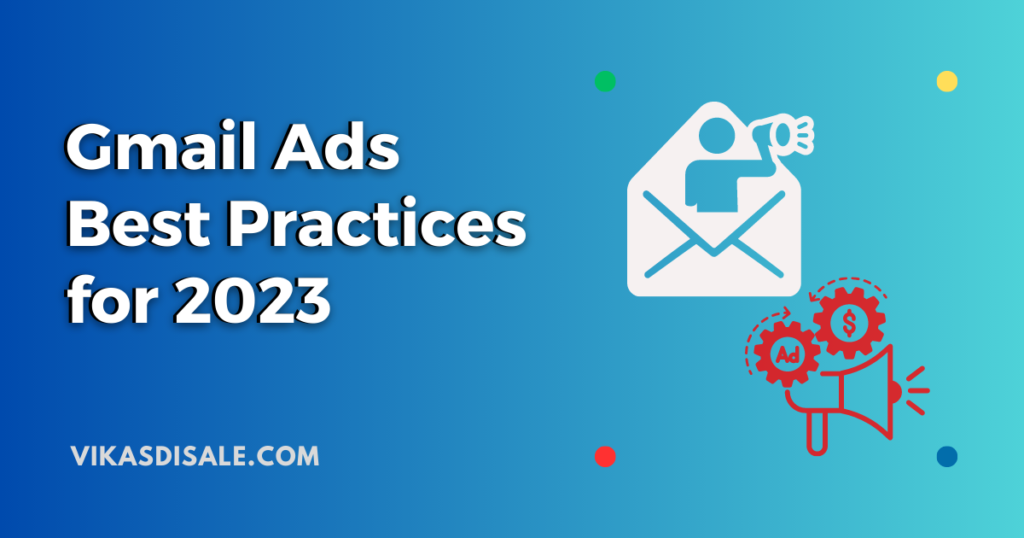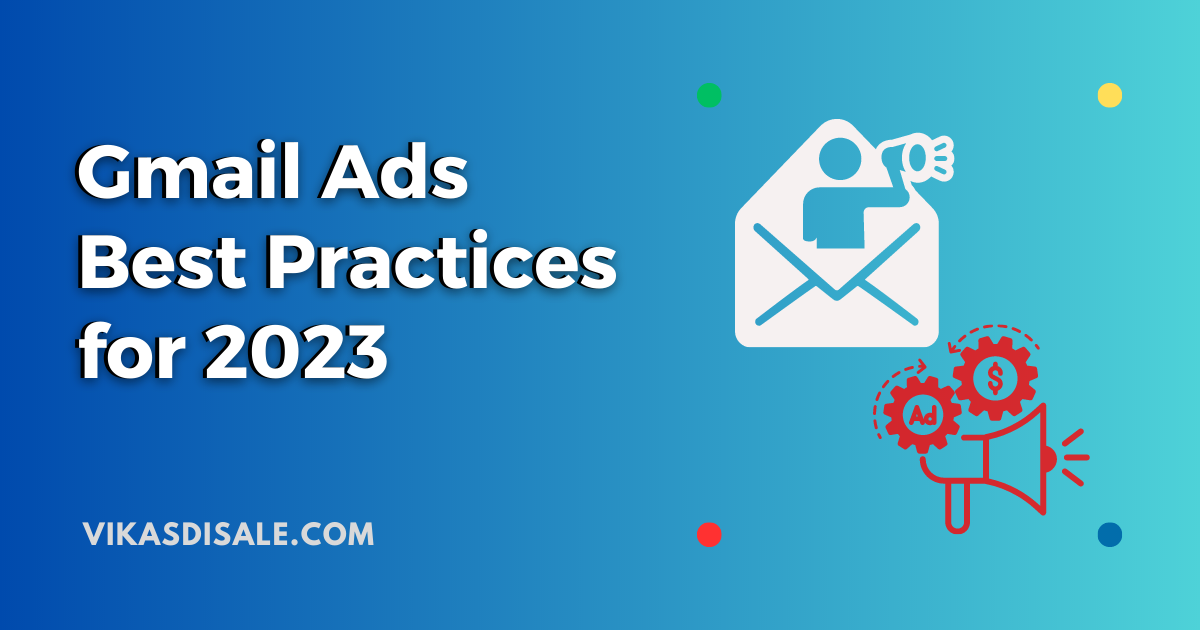
Gmail ads play a crucial role in email marketing strategies by offering a unique and effective way to reach and engage with users directly in their email inboxes. With millions of active Gmail users worldwide, leveraging Gmail ads can significantly expand your reach and improve your campaign’s performance. These Gmail Ads Best Practices will help you to increase your websites traffic.
The Power of Gmail Ads in Email Marketing:
- Gmail ads provide an opportunity to reach users directly in their email inboxes, where they spend a significant amount of time.
- They enable businesses to deliver targeted and personalized messages to potential customers, increasing the chances of engagement and conversions.
- Gmail ads have a visually appealing format, allowing for creative and eye-catching designs that capture users’ attention.
Gmail Promoted Ads
Gmail Promoted Ads, also known as Gmail Sponsored Promotions (GSP), allowed advertisers to display targeted ads in the Promotions tab of Gmail. Please note that specific details and features may have changed since then, as Gmail regularly updates its advertising platform.
Here are the examples of Gmail Promoted ads:
Collapsed Ads:
Collapsed Ads refer to the initial state of Gmail Promoted Ads within the Promotions tab. When users see a collapsed ad, it appears as a regular email subject line with a small teaser text. The collapsed ad is concise and doesn’t reveal all the content upfront, encouraging users to engage further by clicking on it to expand.
In the collapsed state, users have limited visibility of the ad’s content. They can choose to either click on the ad to expand and reveal more information or ignore it and proceed with their inbox browsing. Collapsed Ads are designed to be less intrusive, resembling regular email messages and allowing users to decide whether or not they want to engage further.
Expanded Ads:
Expanded Ads are Gmail Promoted Ads that have been clicked on by users in their collapsed state, expanding to display the full content of the ad. When users expand an ad, it opens up like an email, revealing additional text, images, and calls-to-action.
Expanded Ads provide advertisers with more space and opportunities to showcase their offerings, convey their message, and drive user actions. Users can interact with expanded ads by clicking on links, filling out forms, making purchases, or performing other actions directly within the ad. These ads aim to provide a more immersive and interactive experience, allowing users to engage with the ad content without leaving their inbox.
Setting Up Gmail Ad Campaigns
To create and manage Gmail ads, businesses can use the Google Ads platform. Advertisers can leverage various targeting options such as keywords, demographics, interests, or remarketing to reach their desired audience effectively.
By choosing the appropriate ad type and tailoring the content to resonate with users, businesses can drive engagement, increase brand awareness, and achieve their advertising goals within the Gmail platform.
A. Defining campaign objectives and key performance indicators (KPIs):
- Before setting up a Gmail ad campaign, it is crucial to define clear campaign objectives and the key performance indicators (KPIs) that will measure its success.
- Common objectives may include increasing brand awareness, driving website traffic, generating leads, or increasing conversions.
B. Configuring Gmail ads in Google Ads:
- Gmail ads are managed through Google Ads, making it essential to have a Google Ads account to create and manage campaigns.
- Marketers can access the Gmail ad creation and configuration options within the Google Ads platform.
C. Setting budgets, bidding strategies, and ad formats:
- When setting up a Gmail ad campaign, marketers need to allocate budgets and determine their bidding strategies to ensure optimal ad delivery and performance.
- They also need to choose suitable ad formats, such as single image ads, native ads, or interactive ads, depending on their campaign objectives and target audience.
D. Defining target audiences and leveraging Gmail’s targeting options:
- Defining target audiences is a crucial step in running successful Gmail ad campaigns.
- Marketers should utilize Gmail’s targeting options, such as demographic targeting, interest-based targeting, keyword targeting, and customer match, to reach the most relevant audience segments.
E. Utilizing conversion tracking and analytics for campaign measurement:
- To measure the effectiveness and success of Gmail ad campaigns, it is essential to set up conversion tracking and analytics.
- Conversion tracking allows marketers to track specific actions taken by users after interacting with their Gmail ads, such as purchases, form submissions, or email sign-ups.
- Analytics provide valuable insights into user behavior, engagement rates, and overall campaign performance, enabling marketers to optimize their campaigns based on data-driven decisions.
Ad targeting options:
1. Demographic targeting:
- Demographic targeting allows businesses to reach users based on their age, gender, location, and other relevant demographic factors.
- By targeting specific demographics, marketers can deliver tailored messages to the right audience segments, increasing the relevance and effectiveness of their Gmail ads.
2. Interest-based targeting:
- Interest-based targeting enables businesses to reach users based on their online behaviors, interests, and preferences.
- By targeting users with specific interests related to their products or services, marketers can enhance the chances of engagement and conversions.
3. Keyword targeting:
- Keyword targeting allows businesses to target specific keywords that appear in users’ emails.
- By identifying relevant keywords related to their offerings, marketers can ensure that their Gmail ads are displayed to users who have shown interest in similar topics or products.
4. Customer match:
- Customer match allows businesses to upload lists of existing customers’ email addresses for targeting.
- By matching the uploaded email addresses with Gmail users, marketers can deliver personalized ads to their existing customer base, fostering brand loyalty and encouraging repeat purchases.
Maximizing ROI with Gmail Ads
To maximize return on investment (ROI) with Gmail ads, it’s crucial to continuously monitor and optimize your campaigns based on performance data. Here are some key strategies for maximizing ROI with Gmail ads:
1. Monitoring and analyzing ad performance metrics:
- Tracking impressions, clicks, click-through rates (CTR), and conversions is essential for understanding the effectiveness of your Gmail ads.
- Analyzing audience engagement and demographic data can help you identify trends, preferences, and opportunities for optimization.
2. Optimizing ad targeting:
- Regularly review and refine your target audience to ensure your Gmail ads are reaching the most relevant users.
- Leverage the various targeting options available, such as demographic targeting, interest-based targeting, keyword targeting, and customer match, to refine your audience targeting strategy.
3. Testing and optimizing ad creatives:
- Experiment with different ad creatives, including visuals, headlines, and call-to-action (CTA) buttons, to identify what resonates best with your target audience.
- A/B testing different ad variations can help you determine which elements drive higher engagement and conversions.
4. Utilizing remarketing:
- Implement remarketing strategies to reach users who have previously engaged with your Gmail ads or website.
- Tailor your messaging and offers specifically to this audience segment, as they have already shown interest in your brand.
5. Implementing email marketing and personalization strategies:
- Integrate your Gmail ads with your email marketing efforts to create a cohesive and personalized user experience.
- Leverage insights from your email marketing campaigns, such as user behavior, preferences, and segmentation, to inform your Gmail ad targeting and messaging.
Staying Updated with Gmail Advertising Trends
Staying updated with Gmail advertising trends means keeping yourself informed about the latest changes and developments in how Gmail ads work. It’s important because these trends can help you make your ads more effective and reach your target audience better.
By staying updated, you can learn about new features, targeting options, and creative approaches that can improve your ad performance. You can stay informed by following industry news, reading blogs, exploring Google’s resources, attending webinars or events, and engaging with others in the digital advertising community.
Staying updated with Gmail advertising trends helps you optimize your ads and stay ahead of the competition.
Vikas Disale is Digital Marketer and practicing SEO, Social Media, Paid Ads since 2011. Vikas like to share his knowledge via Podcast, YouTube videos.
